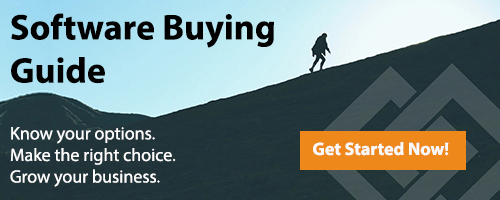One of the most important decisions that a wholesale and distribution business will make, is what (if any) business management software is necessary. For most small businesses, no matter the industry, the first software purchase is made in order to manage the company’s financials and accounting. In this situation, one of the most popular introductory systems is QuickBooks. At this point in time, order volume is still low enough that managing inventory and the picking, packing and shipping process can be easily accomplished with the help of pen and paper or simple business tools such as Excel. However, there will likely come a time when the company starts to grow and order volume increases, and you will start to notice that QuickBooks is not working as well anymore. Frequently, with company growth comes the addition of new sales channels, increased competition and added business complexities such as the need for additional warehouse space. An increase in order volume combined with manual processes results in more room for human errors and more work for employees. It is at this point in time that it is appropriate to begin looking for alternative software solutions.
Software Options
For wholesale and distribution companies looking for software to manage their inventory, accounting, sales, contacts etc. there are a couple of different options depending on required functionality, the sophistication of processes and budget.
Option (1) Introductory Software – Multiple Systems
Introductory software is marketed towards small companies as the first solution implemented in an organization. These systems typically accommodate one business process (such as accounting or inventory management), but in some cases and on the upper end, may accomplish several. Examples include QuickBooks, Simply Accounting, and Fishbowl. For the most part, introductory software is typically designed to accommodate only one business process, and so a company may decide to integrate several standalone solutions in order to accommodate business processes across multiple departments. The training and implementation process is minimal and introductory software is best suited for use by employees with limited accounting knowledge and software experience. For small businesses with slow growth, introductory systems are a great and economical tool for managing processes.
Option (2) Midmarket ERP Software
ERP stands for “Enterprise Resource Planning" and describes software that is designed to manage all aspects of a company’s operations as an all-in-one solution. Midmarket ERP is marketed towards companies that have outgrown their existing introductory software and in certain instances is suitable for start-up businesses. Examples include Blue Link, certain Microsoft products, and Epicor. ERP software includes functionality for accounting, order entry and processing, inventory, contact management and warehouse management, and replaces all existing systems as a stepping stone for continued growth. Certain features that are unavailable in introductory systems, or provided but with very limited functionality, are inherent in true ERP systems. Examples include robust reporting, multiple units of measure, multi-locations and multi-currency, integration with email and the ability to manage unlimited file size and transaction volume. Since ERP systems are designed to scale with company growth, many systems also provide advanced functionality that can either be purchased at the get-go or added on down the road, such as full two-way integration with eCommerce sites, barcode scanning and mobile picking, landed cost tracking, lot tracking and CRM.
Option (3) Top Tier – Global ERP Software
Top Tier ERP systems provide the same functionality as midmarket ERP but on a scale necessary for vast organizations with global operations. They are marketed towards companies with a significant number of users and complex global operations. The sophistication of these pieces of software necessitates a significant capital spend and IT resources. Examples include SAP, Oracle and JD Edwards.
Now that you have a better understanding of the options for software, it is time to determine which one is best for your business. In order to do that, it is important to take a step back to evaluate why you’re looking for new software and the benefits you hope to realize from a new system.
Common Reasons for Shopping
Although there are an infinite number of reasons as to why a company replaces their existing software system, there are a few common ones that we hear most often.
My existing system is antiquated/outdated.
When working with legacy software, there will certainly come a time when you will need to replace the system for a more modern solution, usually as a result of a system crash or lack of support. Because antiquated software has an “expiry” date, it is important to find a new solution before the existing system becomes unusable. It can be enticing to continue to use existing software for as long as possible since it “still works”, but it is very important to dedicate the right amount of time and resources to finding a new solution for when you make the switch. This will allow you to learn a new system, transition from existing software and change processes without needing to rush through each aspect. In this situation even if your existing software was once marketed as midmarket ERP that is not to say that you will have to upgrade to a new midmarket system. Depending on how your business has changed over the years and the amount of growth, it may be appropriate to implement more basic introductory software. Keep in mind that due to changes in technology, many features that are lacking in your existing system will exist in modern ERP software and in some cases, even introductory systems.
In either situation, the biggest hindrance to making the switch when moving from legacy software will be the attitude and commitment from employees and management. Make sure the team is open to change before starting the search.
I do not like certain aspects of my existing system – it won’t integrate with my website, it does not have robust reporting functionality, it lacks inventory management etc.
Although issues with existing systems can be frustrating, its not necessarily reason enough to make the switch to a different solution. If your existing software is lacking functionality do you currently have workarounds for managing these processes? If so, it is important to quantify how these processes affect the company. Consider factors such as:
- Man-hours required
- Number of errors
- Lost opportunities
- Customer satisfaction
If your system is lacking certain functionality but the workaround you created only adds an extra 2 man-hours a month, it's probably not worth making the switch. Is functionality more important than cost? Where does service fit in? Understanding how you prioritize each factor will help you decide if new software is right for your business. Shopping strictly on price will likely lead you to introductory software where midmarket ERP is designed with specific advanced functionality in mind.
I’m looking for a system that is easier to use and all-in-one. I want a system that reduces the number of manual processes.
Let's start with ease of use. I often get asked if our software is user-friendly, but that is such a subjective question. Yes, Blue Link is a Microsoft-based product and so has familiar commands, but for someone who has zero experience with business management software, there will be significant training required to use the system. User-friendliness also applies to processes. Switching systems requires that you also change some of your processes which might be the most difficult aspect of training – learning to operate in a different way than what you’re used to. As a starting point, most vendors will have pre-recorded demo videos that will allow you to get an idea of the look and feel to then make your own assumptions about user-friendliness.
With an all-in-one, ERP system comes fewer manual processes, but the costs reflect this. It is important that when you compare the cost of midmarket ERP with introductory systems or manual processes you compare all the costs. The cost of existing software, hardware, and IT resources, plus non-monetary costs like time spent entering data and correcting mistakes. It is also important to compare future costs – will you need to hire a new employee to enter orders or manage processes without the right software?
Hopefully, by now you have a good understanding of what ERP software is and other types of systems available in the market. Remember, it is still worthwhile to speak with introductory and midmarket ERP software vendors if you’re unsure as to what is right for your business – as long as you approach these conversations with an open mind.











